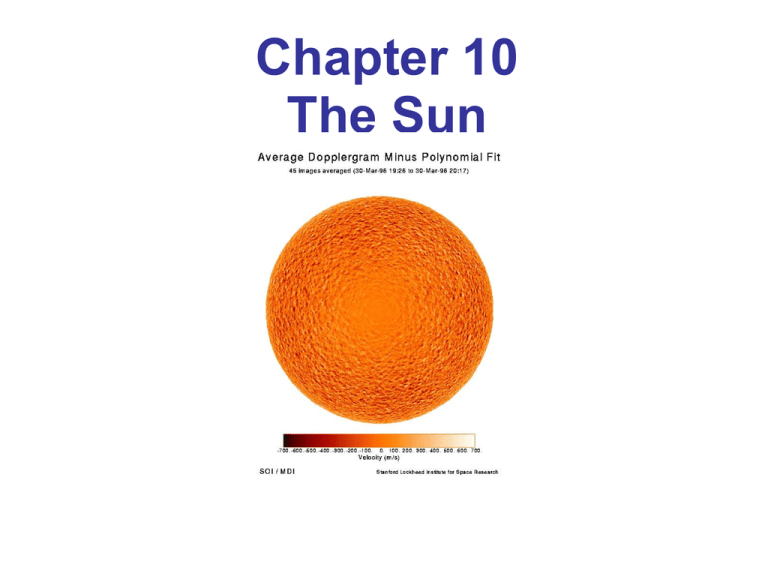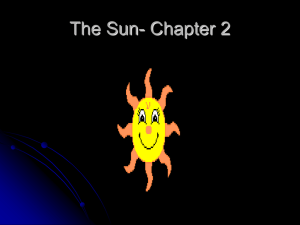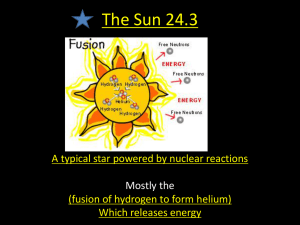Document
advertisement

Chapter 10 The Sun Physical Properties of the Sun Radius: 700,000 km Mass: 2.0 × 1030 kg Density: 1400 kg/m3 Rotation: Differential; period about a month Surface temperature: 5800 K Apparent surface of Sun is photosphere Physical Properties of the Sun This is a filtered image of the Sun showing sunspots, the sharp edge of the Sun due to the thin photosphere, and the corona: Physical Properties of the Sun Interior structure of the Sun: Outer layers are not to scale The core is where nuclear fusion takes place Physical Properties of the Sun Luminosity—total energy radiated by the Sun— can be calculated from the fraction of that energy that reaches Earth. Solar constant—amount of Sun's energy reaching Earth—is 1400 W/m2. Total luminosity is about 4 × 1026 W—the equivalent of 10 billion 1-megaton nuclear bombs per second. Physical Properties of the Sun This diagram illustrates how one can extrapolate from the radiation hitting Earth to the entire output of the Sun: The Solar Interior Mathematical models, consistent with observation and physical principles, provide information about the Sun’s interior. In equilibrium, inward gravitational force must be balanced by outward pressure: The Solar Interior Doppler shifts of solar spectral lines indicate a complex pattern of vibrations. The Solar Interior Solar density and temperature, according to the standard solar model: The Solar Interior Energy transport: The radiation zone is relatively transparent; the cooler convection zone is opaque The Solar Interior The visible top layer of the convection zone is granulated, with areas of upwelling material surrounded by areas of sinking material. The Sun’s Atmosphere Spectral analysis can tell us what elements are present, but only in the chromosphere and photosphere of the Sun. This spectrum has lines from 67 different elements: The Sun’s Atmosphere Spectral lines are formed when light is absorbed before escaping from the Sun; this happens when its energy is close to an atomic transition, so it is absorbed. The Sun’s Atmosphere The cooler chromosphere is above the photosphere. Difficult to see directly, as photosphere is too bright, unless Moon covers photosphere and not chromosphere during eclipse: The Sun’s Atmosphere Small solar storms in chromosphere emit spicules: The Sun’s Atmosphere Solar corona can be seen during eclipse if both photosphere and chromosphere are blocked: The Sun’s Atmosphere Corona is much hotter than layers below it— must have a heat source, probably electromagnetic interactions Solar Magnetism Sunspots: Appear dark because slightly cooler than surroundings Solar Magnetism Sunspots come and go, typically in a few days. Sunspots are linked by pairs of magnetic field lines: Solar Magnetism Sunspots originate when magnetic field lines are distorted by Sun’s differential rotation. Solar Magnetism The Sun has an 11-year sunspot cycle, during which sunspot numbers rise, fall, and then rise again. Solar Magnetism This is really a 22-year cycle, because the spots switch polarities between the northern and southern hemispheres every 11 years. Maunder minimum: Few, if any, sunspots The Active Sun Areas around sunspots are active; large eruptions may occur in photosphere Solar prominence is large sheet of ejected gas: The Active Sun Solar flare is a large explosion on Sun’s surface, emitting a similar amount of energy to a prominence, but in seconds or minutes rather than days or weeks: The Active Sun Coronal mass ejection occurs when a large “bubble” detaches from the Sun and escapes into space. The Active Sun Solar wind escapes Sun mostly through coronal holes, which can be seen in X-ray images. The Active Sun Solar corona changes along with sunspot cycle; it is much larger and more irregular at sunspot peak. The Heart of the Sun Given the Sun’s mass and energy production, we find that, on the average, every kilogram of the sun produces about 0.2 milliwatts of energy This is not much—gerbils could do better— but it continues through the 10-billion-year lifetime of the Sun We find that the total lifetime energy output is about 3 × 1013 J/kg This is a lot, and it is produced steadily, not explosively. How? The Heart of the Sun Nuclear fusion is the energy source for the Sun. In general, nuclear fusion works like this: nucleus 1 + nucleus 2 → nucleus 3 + energy But where does the energy come from? • It comes from the mass; if you add up the masses of the initial nuclei, you will find that it is more than the mass of the final nucleus. The Heart of the Sun Nuclear fusion requires that like-charged nuclei get close enough to each other to fuse. This can happen only if the temperature is extremely high—over 10 million K. The Heart of the Sun . In more conventional notation: 1H + 1H → 2H + positron + neutrino The Heart of the Sun This is the first step in a three-step fusion process that powers most stars: Observations of Solar Neutrinos Typical solar neutrino detectors; resolution is very poor








